In the image above the two photos in rigth hand column represent intense pillarforests with superparhelia rising from nearby lamps. The sight is very impressive as tens of lamps around the observer create pillars. Furthermore, one can see a long circumzenith arc, as all the lamps contribute to it ( 1 ).
Some interesting halo geometries come about when one approaches a spotlight and the light rays become ever more divergent. In the leftmost column there are two examples of that. In the upper photo both car headlights are the light source, and peculiar arcs are formed each side of the lamps. A strong feeling is that these are superparhelia-related. In the lower photo the camera is only 5 meters from the spotlight and almost outside the strongest beam. The shape of the subparhelia gets distorted in a funny way. That effect can also be seen in Jari Luomanen’s photo ( 2 ).
So far we have no definite answer to the origin of these halos, but surely they are a result of quite complex geometries involved in divergent light scattering and represent distorted images of ordinary haloforms. These photos are important in correctness evaluation of divergent light simulation code. Should anyone reading this want to shoot similar images, I suggest that the relative distances are carefully noted so that comparison with simulations can be done.
During the night between 2nd and 3rd January the divergent-light 120° parhelion was seen as well ( 3 ) and some crystals were collected and photographed at the same time ( 4 – 5 ).

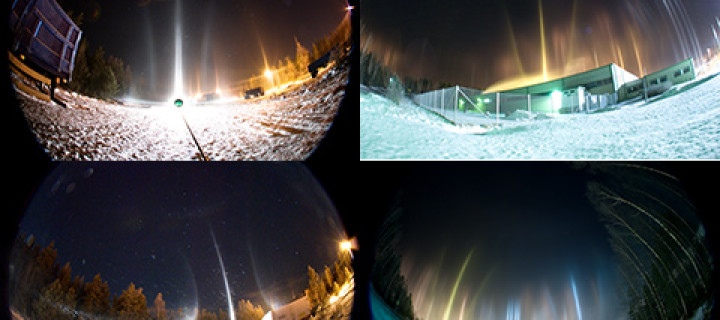
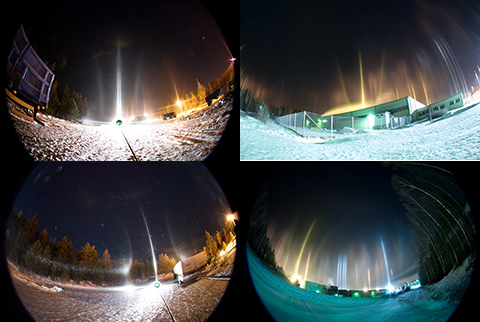
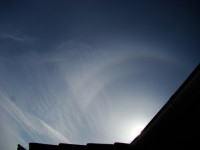
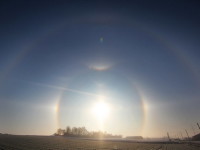
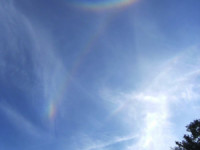
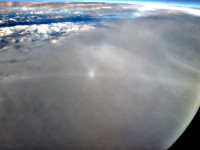
The colors of these photos just please the eye.
And of course you got photographed some previously unseen divergent light effects. With Jari we saw the same stuff next night and the 3D experience of the long smoothly curving arcs together with subparhelia was one of the most impressive things for me. In the 3D space the subparhelia was on the front and the curving arc was a above and “a couple of meters” behind it.
I can only echo Marko’s comment. The 3D impression was so strong and complex that it still plays in my mind like a movie. The arc behind the subparhelia was indeed beautiful and the geometry so clear that it was astonishing. There is a LOT to be explored with these divergent light phenomena.
So beautiful. I’ve been looking forward to your January 2/3 images so much to appear on the blog. It’s not only one step closer to the understanding of these divergent light halos, but images by someone who has an eye for photography.
Very nice! Really interesting is this long CZA. Was it possible to distinguish a few CZA or it was only visible as one broad?
In a display we got in Tampere with Jari, we saw three CZA’s from bright lights in the industrial area. We were in the middle and these lamps were making a triangle, so it looked like there was cza and Kern arc.
What a bombardment of amazing halo observations lately!
From which lamps do the CZA originate in (1)? Can the lamps responsible of the pillars beneath the CZA provide lighting that enters the upper basal face of plate crystals? It’s not quite obvious from the photo that the lamps were able to light the crystals from above.
The cza in (1) may very well be cna with a raypath 2-1-3. In that photo the air was filled with ice crystals down to ground level, but I think you are right: this halo hardly is cza.
Jakub, like Marko already told, the cza – or better cna – can be one broad band, several halos with gap between or even a complete ring. It depends only on the positions of the lamps.
Good point, Lauri. In last November Ylläs ski resort display cza/cna was also present from the ski flank lights ( 1 ). Those lamps were uphill, I would say at least 5 degs above the horizon, so that’s probably more likely cza than cna.
By the way, in simulations at 0 degs elevation cza and cna are seen together ( 2 ). It seems to be stricly 0 degs, at 1 degs it is already either one. This double feature is of course a must see. Kern is similarly double, though separation is by far not that clear.
I like the lower left image with the strange long arcs that curve up from subparhelia